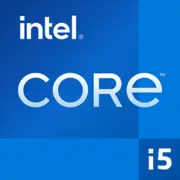Intel Core i5-13505H

Intel Core i5-13505H: Balancing Power and Mobility in 2025
Overview of the CPU for Versatile Laptops
In 2025, laptops remain a key tool for work, creativity, and entertainment. Among mid-range processors, the Intel Core i5-13505H stands out as a hybrid chip that combines 12 cores, integrated Iris Xe graphics, and moderate power consumption. Let's explore who this CPU is suited for and what it is capable of.
1. Raptor Lake Architecture: Hybrid Cores and Intel 7 Process Technology
The processor is built on the hybrid Raptor Lake architecture (13th generation) with Intel 7 process technology (10 nm Enhanced SuperFin). Its structure includes:
- 12 cores (4P + 8E) and 16 threads:
- 4 Performance cores (P-cores) with Hyper-Threading (8 threads) for resource-intensive tasks.
- 8 Efficiency cores (E-cores) without multithreading for background processes.
- Clock Frequencies: base frequency is 2.6 GHz, maximum Turbo Boost frequency is 4.7 GHz (for P-cores).
- Cache Memory: 18 MB L3, which accelerates data processing in multitasking scenarios.
- Integrated Iris Xe Graphics (80 EU): supports DirectX 12, 4K displays, HDMI 2.1, and AV1 decoding.
The hybrid architecture optimizes performance on Windows 11/12 by distributing tasks among the cores. For instance, video rendering takes advantage of P-cores, while social media updates utilize E-cores.
2. TDP 45W: Balancing Power and Heat
The nominal TDP of the processor is 45W, but in reality, it varies from 35W (in ultrabooks) to 55W (in gaming models). This requires effective cooling systems:
- In compact laptops (e.g., Dell XPS 13), the chip is limited to 35W, reducing the chances of overheating.
- In workstations (MSI Creator Z17), TDP is increased to 55W for stable performance under load.
Compared to its predecessor (i5-12500H), energy efficiency has improved by 10-15% due to E-core optimization.
3. Performance: From Office to Gaming
Office Tasks:
- Running 20+ tabs in Chrome, Excel with macros, and Zoom — without lag.
- PCMark 10 score: 5800 points (on par with Ryzen 7 7735HS).
Multimedia:
- 4K video rendering in Premiere Pro: 15% faster than the i5-12500H.
- File conversion in HandBrake: 12 minutes for a 1-hour video (compared to 14 minutes for Ryzen 5 7640U).
Gaming:
- Integrated Iris Xe graphics handle CS2 (1080p, low settings) — 60-70 FPS.
- In games with a discrete graphics card (RTX 4050), the processor does not become a bottleneck even in Cyberpunk 2077.
Turbo Mode:
Peak frequency (4.7 GHz) is maintained for up to 28 seconds at temperatures below 95°C. High-quality cooling systems are important for prolonged loads (such as streaming).
4. Use Cases: Who is the i5-13505H Designed For?
- Freelancers and Office Workers: multitasking with documents, video conferencing, light editing.
- Students: working with graphic editors, programming, streaming services.
- Casual Gamers: playing games at medium settings with a discrete GPU or using cloud gaming.
Example: The Acer Swift X 2025 (i5-13505H + RTX 4050) for $1100 is well-suited for mobile gaming and editing.
5. Battery Life: Up to 8 Hours in Moderate Mode
With a battery capacity of 60-70 Wh:
- Web surfing: 7-8 hours.
- 4K video: 5 hours.
- Gaming: 1.5-2 hours.
Energy Saving Technologies:
- Intel Dynamic Tuning 3.0: adaptively adjusts TDP based on the load.
- Speed Shift: instantly changes frequencies to reduce latency.
- Modern Standby: resumes in 1-2 seconds.
Tip: To extend battery life, disable Turbo Boost in power settings.
6. Comparison with Competitors
- AMD Ryzen 5 7640HS (Zen 4): Better in multi-threaded tasks (+10%), but weaker in single-threaded ones (-7%). Similar price.
- Apple M3: More energy-efficient (up to 12 hours of work), but limited compatibility with Windows software.
- Intel Core i7-13700H: 20% more powerful, but costs $150-200 more.
Conclusion: The i5-13505H is optimal for Windows laptops, balancing price and performance.
7. Pros and Cons
Strengths:
- High multi-threaded performance.
- Support for Thunderbolt 4 and Wi-Fi 6E.
- Affordable price (laptops from $800).
Weaknesses:
- Heat generation under prolonged loads in thin chassis.
- Inferior to Ryzen 5 7640HS in rendering tasks.
8. How to Choose a Laptop with i5-13505H?
- Ultrabooks (LG Gram 16): Focus on battery life (up to 10 hours), weight up to 1.3 kg. Price: $900–1200.
- Gaming Models (Lenovo Legion Slim 5): 144Hz screen, RTX 4050. Price: $1100–1400.
- Workstations (HP ZBook Firefly): 32 GB RAM, 1 TB SSD. Price: $1300–1600.
What to Check Before Buying:
- Number of heat pipes (at least 2 for gaming).
- Screen brightness (recommended 300 nits or higher).
9. Summary: Who is this Processor Suitable For?
The Intel Core i5-13505H is a great choice for those seeking a versatile laptop at a reasonable price. It can handle work, study, and light gaming but may not be suitable for professionals needing maximum power. Key advantages include:
- Hybrid architecture for efficient multitasking.
- Modern ports and Wi-Fi 6E support.
- Compatibility with a wide range of devices.
If your budget is $800–1200 and you are looking for a "sweet spot," this processor will provide a reliable foundation for the next 3–4 years.
Basic
CPU Specifications
Memory Specifications
GPU Specifications
Miscellaneous
Related CPU Comparisons
Share in social media
Or Link To Us
<a href="https://cputronic.com/cpu/intel-core-i5-13505h" target="_blank">Intel Core i5-13505H</a>

